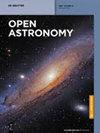磁场对原恒星盘形成的影响
IF 0.5
4区 物理与天体物理
Q4 ASTRONOMY & ASTROPHYSICS
引用次数: 0
摘要
我们对质量为10 M⊙{M}_{\odot}的磁性旋转原恒星云的坍缩进行了数值模拟。在二维MHD代码Enlil的帮助下进行了仿真。在弱、中、强初始磁场条件下,研究了坍缩等温阶段云的结构。模拟揭示了崩塌的原恒星云的普遍层次结构,包括扁平的包膜,内部是准静磁盘,中心是第一个核心。主磁盘的大小随着云的初始磁能的增加而增加。在这种情况下,当云的初始磁能超过其重力能的20%时,磁制动有效地将角动量从主盘传输到包膜中。从第一个磁芯边界附近区域发射的流出物强度随着初始磁能的增加而增加。电离率小的“死”区,x <1 0−11 x\lt 1{0}^{-11},在第一个流体静力核心内部和流出的底部形成。欧姆耗散和双极扩散决定了该区域原恒星盘进一步形成的条件。本文章由计算机程序翻译,如有差异,请以英文原文为准。
Influence of the magnetic field on the formation of protostellar disks
We numerically model the collapse of magnetic rotating protostellar clouds with mass of 10 M ⊙ {M}_{\odot } . The simulations are carried out with the help of 2D MHD code Enlil. The structure of the cloud at the isothermal stage of the collapse is investigated for the cases of weak, moderate, and strong initial magnetic field. Simulations reveal the universal hierarchical structure of collapsing protostellar clouds, consisting of the flattened envelope with the qausi-magnetostatc disk inside and the first core in its center. The size of the primary disk increases with the initial magnetic energy of the cloud. The magnetic braking efficiently transports the angular momentum from the primary disk into the envelope in the case, when the initial magnetic energy of the cloud is more than 20% of its gravitational energy. The intensity of the outflows launched from the region near the boundary of the first core increases with initial magnetic energy. The “dead” zone with small ionization fraction, x < 1 0 − 11 x\lt 1{0}^{-11} , forms inside the first hydrostatic core and at the base of the outflow. Ohmic dissipation and ambipolar diffusion determine conditions for further formation of the protostellar disk in this region.
求助全文
通过发布文献求助,成功后即可免费获取论文全文。
去求助
来源期刊

Open Astronomy
Physics and Astronomy-Astronomy and Astrophysics
CiteScore
1.30
自引率
14.30%
发文量
37
审稿时长
16 weeks
期刊介绍:
The journal disseminates research in both observational and theoretical astronomy, astrophysics, solar physics, cosmology, galactic and extragalactic astronomy, high energy particles physics, planetary science, space science and astronomy-related astrobiology, presenting as well the surveys dedicated to astronomical history and education.
 求助内容:
求助内容: 应助结果提醒方式:
应助结果提醒方式:


